Protecting People Through Quick Deployment Flexible Containment Systems
 Powder potency and toxicity continues to increase across the life sciences industry as new pharmaceutical therapies are developed. These hazardous powders introduce a significant process risk due to potential exposure to chemical operators and scientists as they handle these powders. Safe powder handling requires properly designed engineering controls beyond Personal Protective Equipment (PPE). Often these engineering controls must be deployed on very short notice to prevent process downtime.
Powder potency and toxicity continues to increase across the life sciences industry as new pharmaceutical therapies are developed. These hazardous powders introduce a significant process risk due to potential exposure to chemical operators and scientists as they handle these powders. Safe powder handling requires properly designed engineering controls beyond Personal Protective Equipment (PPE). Often these engineering controls must be deployed on very short notice to prevent process downtime.
Most safety data sheets (SDS) will provide an Operator Exposure Level (OEL) based on a toxicological report of that powder. OEL is measured as an airborne concentration and expressed as micrograms per cubic meter (µg/m3 ). This number provides the total exposure level allowed over an 8 hour time weighted average. Some SDS’s will also provide a short term exposure limit (STEL) which is the total exposure of that powder over a 15 minute period. When the powder OEL is not known or stated in the SDS, the material should be tested by a toxicologist or a company safety policy should be in place for procedures on the handling of those powders.
 Powders with a low OEL will require some form of restricted access barrier system (RABS), such as an isolator or enclosure with safe material airlocks. A traditional RABS includes a hard-wall, negative-pressure glovebox isolator with sophisticated entry and exit systems. These isolators are often custom designed, expensive, and can have long delivery times (many months).
Powders with a low OEL will require some form of restricted access barrier system (RABS), such as an isolator or enclosure with safe material airlocks. A traditional RABS includes a hard-wall, negative-pressure glovebox isolator with sophisticated entry and exit systems. These isolators are often custom designed, expensive, and can have long delivery times (many months).
Flexible Containment Isolators: Quick Deployment Engineering Control
 Flexible containment solutions, such as Rheo Flexibles single use enclosures, offer a fast and effective containment strategy. These soft-wall enclosures are manufactured from a high durability, qualified film with integrated glove ports as well as several other process critical features. The enclosure systems are attached to a stainless steel frame structure and can be assembled in a matter of minutes. The flexible structure is suspended on elastic bungees to offer improved ergonomics and ease of use for the various activities required inside the enclosure.
Flexible containment solutions, such as Rheo Flexibles single use enclosures, offer a fast and effective containment strategy. These soft-wall enclosures are manufactured from a high durability, qualified film with integrated glove ports as well as several other process critical features. The enclosure systems are attached to a stainless steel frame structure and can be assembled in a matter of minutes. The flexible structure is suspended on elastic bungees to offer improved ergonomics and ease of use for the various activities required inside the enclosure.
Features such as drum entry ports or smaller canister ports use a single use sleeve and a cut and crimp procedure to allow powders to be brought into the enclosure without opening it to the environment. Process gases such as nitrogen or process air, as well as solution (water, etc.), can be plumbed into these enclosures through integrated quick-connect ports.
Activities such as drawing powder samples, subdividing, small scale blending, and milling are common activities that require high containment enclosures. Subdividing from higher volume containers such as drums or bins into smaller containers will require a safe make/break connection after the powder is transferred into the smaller container.
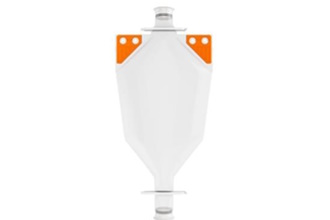
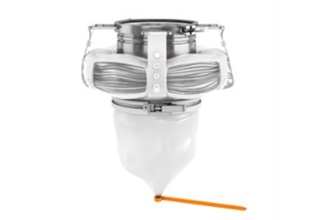
The RheoPac equipped with a single use split butterfly valve can achieve very high containment performance as the powder is weighed and then poured into the single use bag.
The Continuous Liner is a common method for transferring items into the enclosure using a bag-in/bag-out port. It is also used to transfer out waste or other materials. This process requires a cut and crimp procedure to prevent breaching the containment integrity of the enclosure.
The RheoCrimp is a new crimp system that offers significant improvement to the user experience while conducting the separation procedure. The wide-opening, wrap around design makes it easier to enclose the bulky liner material compared to the conventional “fixed-opening” crimps on the market.
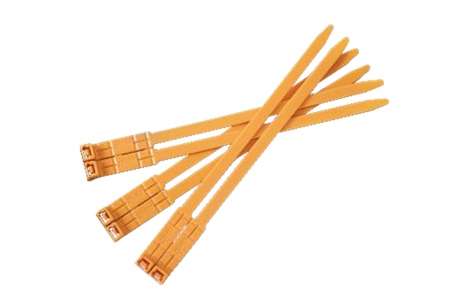
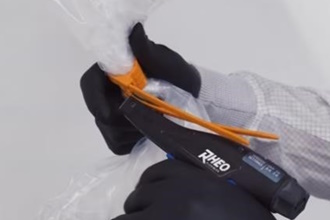
Single-Use Systems Reduce Cleaning Requirements and Cross Contamination Risk
Quick deployment is not the only advantage of flexible containment systems. The low cost of these containment devices allows them to function as a single-use solution, which eliminates the potential of cross contamination between powders or batches due to inadequate cleaning processes. Set-up of these systems can usually be accomplished in 5-10 minutes depending on the complexity of the enclosure. Once the powder handling process is complete, the inside surfaces are often misted with a spray bottle and the enclosure is collapsed and discarded. This single-use purpose dramatically reduces the risk of cross contamination between powders or batches.
Dynamic vs. Static Flexible Isolators
For certain high-potency applications it makes sense to maintain a negative pressure environment with the flexible enclosure via a dynamic isolator. This provides improved containment by pulling airborne powders away from the material transfer area and can reduce dust cloud build-up within the powder workspace. Dynamic isolators require a fan unit to pull the air through the enclosure. The fan units must have a finely controlled fan speed range to ensure the proper pressure drop across the integrated filter system on the enclosure. If there is too much negative pressure then enclosure can be difficult to work in or even be damaged, if not enough then the containment confidence is compromised. The RheoFan Unit provides continuous monitoring of the enclosure pressure and automatically modulates flow rates to maintain a given pressure set point. This ensures that even if the filter inside the enclosure becomes loaded, the fan unit can increase speed to maintain the necessary negative pressure.
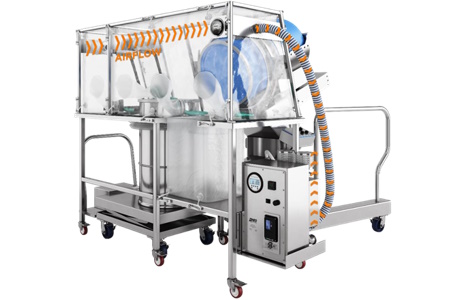 Sustainability & Single Use
Sustainability & Single Use
Sustainability is a frequent question that is associated with the use of single-use technology. While evaluating containment and powder handling solutions, it is important to consider two primary factors when it comes to sustainability concerns: cleaning and storage.
The wastewater associated with cleaning hard-wall isolator systems and stainless steel containers, such as bins or bottles, can be substantial. A short CIP cleaning cycle for a simple two-glove isolator can use well above 50 gallons of cleaning solution. This contaminated cleaning solution water or solvent must be contained, transported, and disposed of safely. The management of this waste stream is costly and has many downstream environmental risk factors. A single-use containment isolator can be collapsed and placed into a disposal bag or drum where it can be safely incinerated.
Stainless steel, hard-wall systems (bins or isolators) can take up a lot of storage or warehouse space when not in use. This space is expensive (especially if in a GMP controlled area) and requires air handling systems along with other utilities. Single-use systems come collapsed and boxed in a much smaller space until they are needed for a batch.
Selection of Containment Systems
One size does not fit all when it comes to containment solutions. Engineering controls must be evaluated based on many factors and the selection process is an exercise in engineering and process risk management. Deployment time, containment performance targets, footprint, task duration and frequency, powder volume, material handling integration, and many other factors contribute to a proper evaluation and selection.
Rheo Engineering is a full suite containment provider, our team of application engineers can help during the selection of the right control for the process.
For more information, visit www.rheoengineering.com.
Source: RHEO Engineering
